Global Strategy
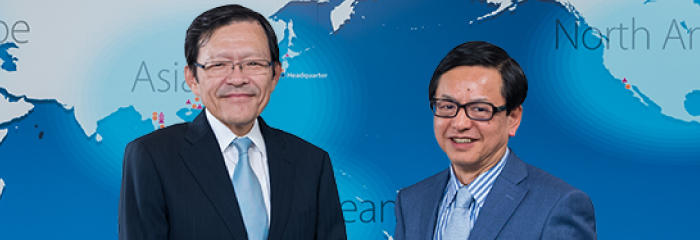
Aiming to become a true leading company through aggressive investment while taking balance in financial circumstances into account
Global Business Strategy and Accounting Department Management Discussion UACJ Global Strategy
Profile
Takayoshi Nakano
Director, Member of the Board Senior Managing Executive Officer Responsible for Global Business Strategy Department and Public and Investor Relations Department President and Director, Tri-Arrows Aluminum Holding Inc.
Hisashi Hasegawa
Director, Member of the Board Managing Executive Officer Responsible for Finance and Accounting Department and Corporate Planning Department
Director, Member of the Board Senior Managing Executive Officer Responsible for Global Business Strategy Department and Public and Investor Relations Department President and Director, Tri-Arrows Aluminum Holding Inc.
Hisashi Hasegawa
Director, Member of the Board Managing Executive Officer Responsible for Finance and Accounting Department and Corporate Planning Department
The UACJ Group has been working to build a foundation for global-scale businesses with the aim of becoming
a major aluminum industry leader in a competitive global market.
Mr. Nakano, Senior Managing Executive Officer, and Mr. Hasegawa, Managing Executive Officer, discuss the background of the Group’s aggressive investment strategies since integration, its decision-making processes,and future issues.
Driving Aggressive Strategic Investment
to Capture Business Opportunities,
while Considering Financial Soundness
- ―――
- UACJ has been implementing large-scale investments mainly in North America and Asia since the merger. What do you think about the investment strategy to date?
- Nakano:
- The main reason for our active large-scale investments is that we believe the global aluminum industry is currently entering a major growth phase. In recent years, economic growth in emerging markets such as Southeast Asia, India, the Middle East and Africa has led to an increase in demand for can stock and general materials. Meanwhile, in developed countries as well, demand for aluminum panels and structural materials is rapidly expanding in line with the call for lighter vehicles. These are signs of a big opportunity, one matching that which came around 1990 when steel beverage cans were replaced by aluminum cans. It could turn out to be an even bigger chance than that.
- Hasegawa:
- It is imperative to ensure that we take advantage of the waves of change and deliver business growth. Expecting a solid increase in demand in the surrounding areas, it was decided to implement a third phase of capital investment in Thailand, where our Asian hub, UACJ (Thailand) Co., Ltd. is situated. In the North American market, too, we established the joint venture Constellium-UACJ ABS LLC (CUA) to promote our automotive body sheet operations. In addition, we welcomed a leading company in the automotive structural materials and parts industry to the UACJ Group and made it a subsidiary, UACJ Automotive Whitehall Industries, Inc. (UWH).
- Nakano:
- At the same time, we made investments at the Logan Mill of TAA in order to increase the capacity for supplying can stock and base materials for automobiles in the North American market. We will consider additional investment in the afore-mentioned automotive body sheet operations at CUA and structural materials and parts operation at UWH depending on the increase in demand. Moreover, following the trend in North America, the market for automotive body sheet and structural materials will undoubtedly grow in Japan and Other parts of Asia. It is imperative for us to continue to invest in these growth markets and fields in order to secure market share.
- Hasegawa:
- Absolutely. It goes without saying that we need to continue investing proactively. However, in order for UACJ to ensure sustainable growth as a global company, it is essential to maintain a healthy financial position while simultaneously pursuing business expansion through upfront investments.
- Nakano:
- In the past four years since integration, our stance was that it was an important phase of investment for future growth and upfront investment was prioritized. As a result, free cash flow has been negative. However,we cannot allow this situation to continue forever. We have to take balancing our overall financial position into consideration; for example, by trying to expand the profits from businesses we have invested in so far.
- Hasegawa:
- Aggressive upfront investment means accumulating promising assets. On the other hand, there are risks in doing this too. Even though individual projects may be very promising assets from a long-term perspective, if they are unable to generate profits as planned, the financial balance can suffer as a result. Therefore, it is vital to manage them using the PDCA cycle.
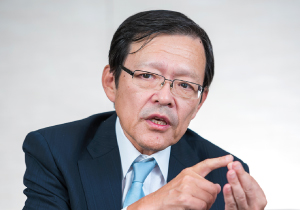
- Nakano:
- None of our investment projects are given the go-ahead without thorough discussions and examination. Nonetheless, there is a risk that assumed external conditions could change more dramatically than anticipated and this may produce some divergence from our plans.
- Hasegawa:
- As a person responsible for finance and accounting, I think that it is paramount for the company, and the Group as a whole, to have a solid financial foundation in place that enables us to continue growing without problems, even when things don’t go as planned.
- Nakano:
- As part of our efforts to reinforce the financial foundation, in March, we raised funds amounting to around 55 billion yen through a new stock issuance of around 14.6 billion yen and taking on a subordinated loan of 40 billion yen.
- Hasegawa:
- From the financial viewpoint, had we relied totally on the public offering, shareholder equity would have been bolstered, thereby increasing financial security. On the negative side, it would have led to greater stock dilution. Therefore, we thought that simultaneously securing funds through a subordinated loan, which has an intermediary nature between assets and debts, would ensure that dilution was restricted to a minimum, thereby enhancing the stability of our financial foundation.
- Nakano:
- In November 2016, it was decided that the projects in Thailand and North America require funding. An important management issue is that we ensure stable financing while maintaining a healthy financial position.
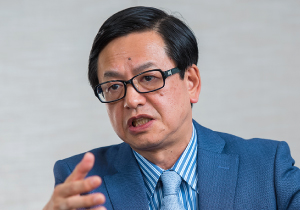
- ―――
- What do you think about UACJ’s governance regarding important decision-making such as strategic investment and financing?
- Nakano:
- UACJ’s decision-making processes are distinguished by thorough internal review at department-level meetings in addition to review during BOD and Auditors’ meetings that include outside directors and auditors, respectively. This is the result of the management integration at the time of establishing UACJ. Every agenda item has to be thoroughly explained and discussions must follow proper procedures. Otherwise, things do not move forward. I think this is very good in terms of governance. Additionally, among internal board members, some are looking at new investments from the strategic planning perspective, like me; while others attach importance to financial disciplines, like Mr.Hasegawa. As there are different opinions internally, I think this is one of the features of our decision-making processes that enables us to maintain a fine balance between braking and accelerating. As a consequence, there is little risk of getting carried away.
- Hasegawa:
- Personally, I am not against investing, but I never hesitate to express my opinion either. Regardless of how attractive an investment may seem, what really matters is whether or not it is really the best option at this moment in time among the many investment projects in the pipeline.
- Nakano:
- Through serious discussions where these different views are vigorously exchanged, decisions are finally made. So, by the time a project is brought up for discussion at a board meeting, the stage should be set for making a decision with conviction.
- Hasegawa:
- We want to maintain this culture, where we can speak freely and different opinions are respected.


On the Road from Improvement towards Innovation—Challenges for 21st Century Manufacturers
- ―――
- Finally, please share your views on future issues for UACJ with us.
- Hasegawa:
- Since integration, we have been focusing on strategic investment for future growth, and this restricted our investment in general maintenance of facilities. However, in order for UACJ to achieve medium- to long-term growth in the future, it is necessary that the maintenance of existing plants and equipment be carried out as well. There will also be a need for major facilities renewal at some stage, alongside business measures and R&D.
- Nakano:
- In the manufacturing industry, the effort to introduce more sophisticated factory floors is intensifying. This includes using IT, such as the Internet of Things, big data and 3D printers, and movement is focused on process- and assembly-oriented sectors such as electronics and automobiles. Maybe the aluminum industry, too, will eventually face the need to update plants from “20th century” production lines to “21st century” production lines?
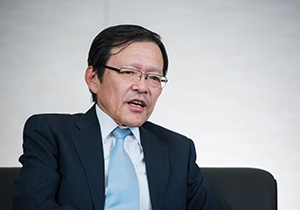
- Hasegawa:
- Absolutely. I think that behind calls for innovation on the factory floor, it is not only the aim to improve productivity and business competitiveness, greater change in the social environment is also being witnessed. As labor forces shrink due to falling birthrates and aging populations, we will see more female and older workers in the manufacturing industry, among other sectors. Although many types of work have been mechanized and automated, there are still some jobs that must be done by human hands. Therefore, we need to reform the working environment so that female and elderly workers who are not as strong as adult males will be able to work effortlessly and safely.
- Nakano:
- Furthermore, as our operations expand abroad, there will be more people coming to work at offices in Japan in the form of trainees from the overseas group companies in Southeast Asia and other regions, or possibly remaining in Japan to work at UACJ after studying here. In order to ensure that these people can fulfill their potential, we have to build a system in which production facilities can be operated without difficulty, even by those who cannot write or read Japanese.
- Hasegawa:
- In other words, the creation of new factories and offices is required to cope with social change, such as the diversification of human resources and globalization. Needless to say, such efforts should be extended at the global scale beyond Japan.
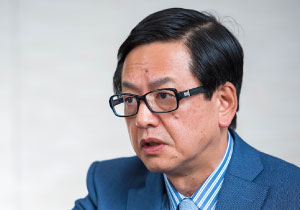
- Nakano:
- Since integration, UACJ has been focusing on the construction of a global business network through aggressive upfront investment. As a result, tangible infrastructure at production bases and other facilities has improved and the depth of our human resources has also been enhanced. From now on, in the second phase, we must further strengthen the intangible infrastructure; for example, make the most of cutting-edge IT, and reinforce human resources and organizations. Through these measures, we need to pursue sophisticated operations fit for a 21st century manufacturer.
- Hasegawa:
- In order to ensure that the entire Group can press forward with such innovation, we are going to keep a close eye on the management of Group companies, both in Japan and overseas. Additionally, in order to ensure effective governance of the Group as a whole, it is important that a shared vision and values are thoroughly understood by every director and employee alike.
- Nakano:
- At UACJ, strong attachment to “manufacturing”, which was cultivated by the two former companies prior to integration, is still handed down constantly. For instance, if income has improved by 10 billion yen, we definitely prefer it coming from the pursuit of manufacturing rather than accounting gains stemming from inventory valuation. No matter how far our businesses expand across the world, or how big the company becomes, our values, in which the basics of manufacturing—producing and delivering products that please customers—are found, remain the same.
- Hasegawa:
- Eventually, it leads to contributing to society.
- Nakano:
- Our goal is for UACJ to venture into 21st century manufacturing with the entire Group maintaining these values.

